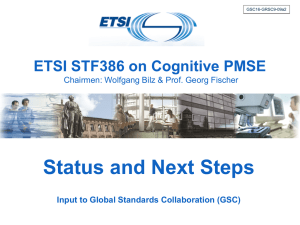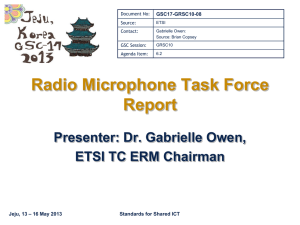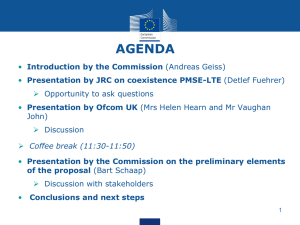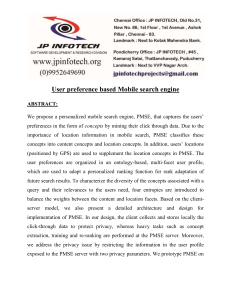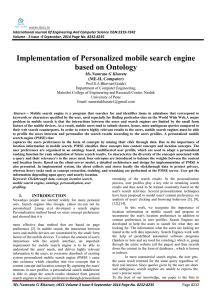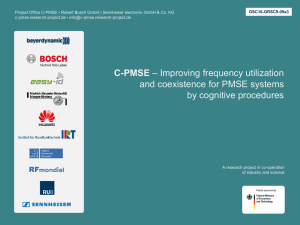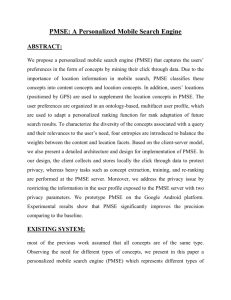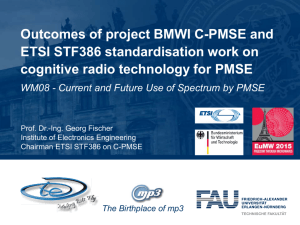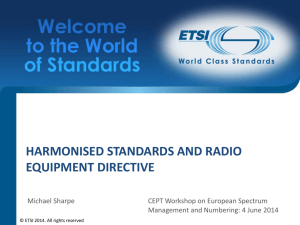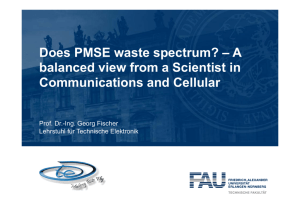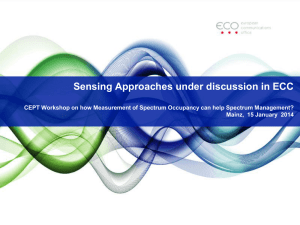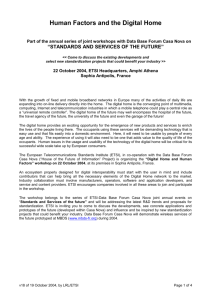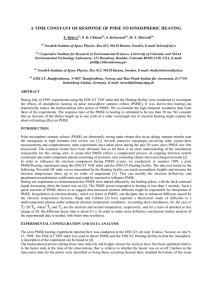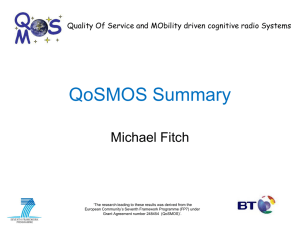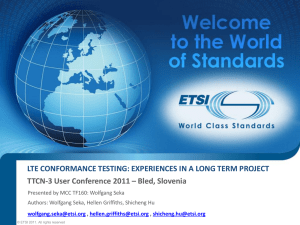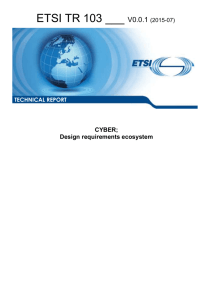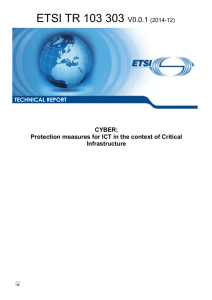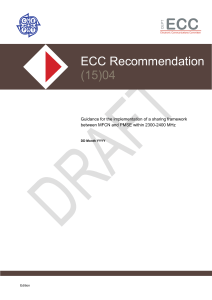ETSI Cognitive-PMSE - GSC-15
advertisement
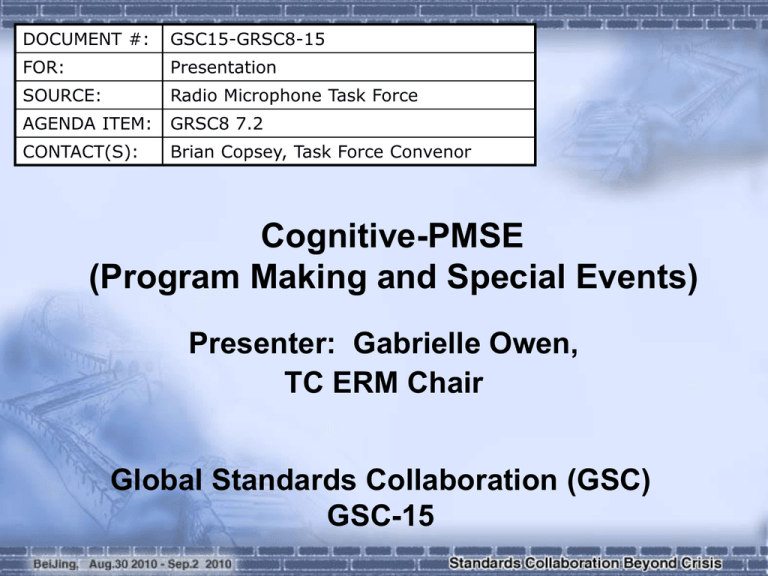
DOCUMENT #: GSC15-GRSC8-15 FOR: Presentation SOURCE: Radio Microphone Task Force AGENDA ITEM: GRSC8 7.2 CONTACT(S): Brian Copsey, Task Force Convenor Cognitive-PMSE (Program Making and Special Events) Presenter: Gabrielle Owen, TC ERM Chair Global Standards Collaboration (GSC) GSC-15 Agenda 1. What is PMSE? 2. ETSI STF386 overview 3. Specific PMSE requirements 4. C-PMSE (Cognitive PMSE) 5. Conclusions 2 1. What is PMSE - Definitions Definitions • PMSE = Program Making and Special Events • PWMS = Professional Wireless Microphone system • IEM = In Ear Monitor • SAB = Services Ancillary to Broadcasting • SAP = Services Ancillary to Programme making • PMSE not only includes wireless audio, but also wireless video • PMSE is operating as secondary user in TV spectrum 3 1. What is PMSE - Applications Applications Broadcast TV/Radio • Productions of any kind; Recordings for CD/DVD/Internet distribution Live shows; Reportages, Interviews ENG – Electronic News Gathering; OB – Outside Broadcast Professional applications – Program production • Opera, Theatre, Musical,Shows, Concert hall / event halls, Congress centers, Cabaret,Clubs, bars, casino, PMSE delivers Live events, music, festivals the content for Press centers, Conference centers Bodypack for ENG prof. distribution And much more.. Wireless microphone systems 4 2. ETSI STF386 Instrument STF • ETSI Specialist Task Force • Expert team working for a limited period of time • Focus on a specific technical question Scope • Set by ToR (Terms of reference): “Methods, parameters and test procedures for cognitive interference mitigation techniques for use by PMSE devices (Programme Making and Special Events)” • Purpose: Achieve co-existence of high audio quality PMSE devices using often a 100% transmitter duty cycle emission profile with victim radio services such as Services in L-Band or Broadcast Services and future Land Mobile Services and applications in the UHF frequency range that is currently under investigation under the “Digital Dividend” discussions in EC, ECC and ETSI fora. 5 2. ETSI STF386 Phases Phase 1: ETSI TR 102 799 on “Operation methods and principles for spectrum access systems and quality control of used spectrum for PMSE technologies and the guarantee of a high sound production quality on selected frequencies utilising cognitive interference mitigation techniques”: published June 2010. • Phase 2: ETSI TS 102 800 on “Protocols for spectrum access and sound quality control systems using cognitive interference mitigation techniques”: TB approval Sept. 2010. • Phase 3: ETSI Technical Report of the different RF compliance tests for the selected spectrum access mechanism: TB approval mid 2012. 6 3. PMSE technical requirements Highest Audio Quality demands • Serve studio/CD quality 44 kSa/s,16 bit (Current state. Develops!) • Lowest latency < 3ms roundtrip (drummer: mic-mixing console-monitor) • No interruptions, availability 100% of time • Calculation: Mic Audio SNR: 100 dB (orchestra even does 140 dB) Compander gain: 40 dB (analogue, no significant delay!) FM process gain 10 dB (20 kHz Audio on 200 kHz channel) Results in 50 dB C/I on RF channel Actual Technology • Analogue transmission, digital source coding would cause too much delay • FM modulation • Constant Envelope provides long operation time for wireless microphones and body pack instrument transmitters • Proprietary digital systems just enter the market. 7 4. C-PMSE architecture Scanning Receiver Subsystem (SCS) Scanning Receiver (SCR) Frequency coordinator (FCO) m fci Multiple sniffers! Hierarchical database with geolocation Regulatory Scanning Receiver Controller (SCC) fci sci sci Radio Resource Manager (RRM) Service Level Entry (SLE) REM Cognitive Engine (CEN) LPS sli Fusion Engine (FEN) Cyclic Unit (CYU) FAT PAT AMCT DAT cpi RRM rmi ASQ DecisionMaker Engine (DEN) Optimisation Engine (OEN) cmi Preferably Proactive rather reactive ! rpi Service Level Monitor (SLM) CEN Database n Performance Monitor (PMO) Radio Link C-PMSE 1 C-PMSE 2 8 4. Hierarchical database Database at Regulator More seldom updates More accurate location information Frequency Coordination Database (FCO) Optional Regional Database Local Database inside C-PMSE (REM) Use same approach as in IP world: • DHCP lease for IP adress, grant valid for a certain lease time • Use offline copy, no permanent connectivity required • M2M or manual Web interface for legacy support Local Database inside C-PMSE (REM) 9 4. Cognitive Engine Rationale • Ultimate goal: Avoid drop of audio quality • Predict upcoming risks for a hit of audio quality • Try to stay on predictive path • Only in seldom cases act reactive 10 Supplementary Information: ETSI TR 102 799 (available from ETSI website) and draft ETSI TS 102 800 (see Annex a1 to this presentation) 11
